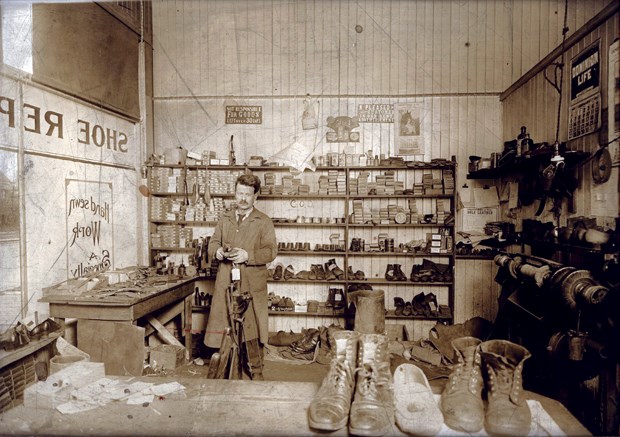NANITCH: Early Photographs of British Columbia from the Langmann Collection at Presentation House Gallery until June 26.
– Saturday, April 16, 7:30 p.m., Exhibition Reception.
– Monday, April 18, 7 p.m., Gold Nuggets and Silver Salts: The Photographic Legacy of Frederick Dally, Lecture by Joan Schwartz.
– Thursday, May 12, 7:30 p.m., Exhibition Tour with Uno Langmann.
For more information visit presentationhousegallery.org/exhibitions/now.
Presentation House Gallery’s NANITCH challenges the dominant narrative of progress by balancing feats with failures, giving truth to the province’s history through a photographic exploration in time.
Drawing from the Uno Langmann Family Collection of B.C. Photographs, donated to UBC in 2014, PHG curators sifted through 18,000 prints and negatives to create the exhibition.
“What we’ve done here is we’ve really emphasized the importance of albums,” says curator Helga Pakasaar. “In general the importance of how photographs were not so much meant to be seen as single pictures on the wall, but rather as part of groups and sequences … to give this immersive sense of this land that, in many cases, they wanted to indicate wasn’t really wild, but something that is being domesticated and is beautiful without the negatives attached to that.”
Now a ghost town located near Kamloops, Walhachin was created as a packaged community to attract English settlers to the province. The album lays out Victorian homes placed in the middle of a flat, desert-like landscape. Flourishing orchards are pictured at the height of the day with attractive patches of shade, and irrigation trellises are evidence of the engineering that portray the community as established and ready for the taking. But a misunderstanding of the land caused the vision to collapse. Orchards don’t survive well in the centre of B.C.’s dry belt.
Viewers of the exhibition can flip through the album of Walhachin on touch screens that display scanned images from the collection.
A role of more singular images is represented in the form of postcards. Ranging from more photojournalistic genres, one postcard shows a free speech demonstration, while other postcards depict tailored, hand-tinted images of landscapes and people.
“We wanted to, in the way the exhibition is laid out, kind of emphasize the seriality of pictures and the proliferation, really, of a lot of this kind of material,” says Pakasaar. “Often the names change or the information that might have been with this originally of course becomes something different when it’s more mass produced.”
In one display, starting with the original photograph, a lineup of First Nations chiefs is captured and titled “Indian Chiefs.” The original is followed by four other representations of the same image, each progressing to feature more colour and a closer crop. Pakasaar says that the indigenous leaders were on their way to England to petition land rights, potlach laws and hunting issues in front of the Crown.
“So a very momentous occasion, a very significant occasion, then is turned into a postcard which served very different purposes. It’s commodified in a way, you have to wonder why there are four different versions. Once it had that name on it, it was stripped of its political import. I would say all postcards probably were because they were so singular. So the context became quite neutralized.”
Photographers were in demand in this booming era of change, contracted by ethnographers, surveyors and businesses, but some of the images that emerged from this early period lend an element of mystery behind their intended purpose. Pakasaar has spent time delving into the vague inscriptions attached to each photo to try to discover their stories, however, for one section the curators have deemed the “sublime,” the mystery of the more abstract images is left to intrigue the viewer.
“(What) we’re trying to bring out is invisibility or things that are hard to see,” she says. “We’re looking mostly at documentary photographs, so they’re very depictive and yet at the same time there are these vagaries like the aurora borealis … where things are not quite clear in terms of what exactly is being pictured.”
As the practice of photography became more commercial, people from all social levels began to pose for portraits showing their standing in a community and preserving memories in a way that wasn’t previously possible. The collection of portraits within the exhibition take on an eerie and magical presence as the faces framed stare back at the viewers from a time when each slide held an air of prominence and worth.
“You could dress up for the camera, be what you wanted to be and they were keepsakes,” she says. “The role of photography was so important, not just the camera being a tool for substantiating all these colonial ambitions and projects, but also in terms of how people of all social means were able to, not just participate, but were an integral part around the production of meaning around photography.”



